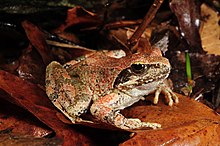
The common frog or grass frog, also known as the European common frog, European common brown frog, European grass frog, European Holarctic true frog, European pond frog or European brown frog, is a semi-aquatic amphibian of the family Ranidae, found throughout much of Europe as far north as Scandinavia and as far east as the Urals, except for most of Iberia, Southern Italy, and the southern Balkans. The farthest west it can be found is Ireland. It is also found in Asia, and eastward to Japan. The nominative, and most common, subspecies Rana temporaria temporaria is a largely terrestrial frog native to Europe. It is distributed throughout northern Europe and can be found in Ireland, the Isle of Lewis and as far east as Japan.

The Greek tortoise, also known commonly as the spur-thighed tortoise, is a species of tortoise in the family Testudinidae. Testudo graeca is one of five species of Mediterranean tortoises. The other four species are Hermann's tortoise, the Egyptian tortoise, the marginated tortoise, and the Russian tortoise. The Greek tortoise is a very long-lived animal, achieving a lifespan upwards of 125 years, with some unverified reports up to 200 years.

The pickerel frog is a small North American frog, characterized by the appearance of seemingly "hand-drawn" squares on its dorsal surface.

The foothill yellow-legged frog is a small-sized 3.72–8.2 cm (1.46–3.23 in) frog from the genus Rana in the family Ranidae. This species can be found in the Coast Ranges from northern Oregon, through California, and into Baja California, Mexico as well as in the foothills of the Sierra Nevada and southern Cascade Range in California. The foothill yellow-legged frog is a Federal Species of Concern and California State Endangered.

The agile frog is a European frog in the genus Rana of the true frog family, Ranidae.
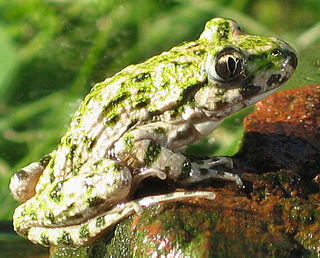
Pelodytes punctatus, or the common parsley frog, lives across the Iberian region in south-western Europe. It is one of several other parsley frog species, and part of the Family Pelodytida and the Genus Pelodytes.
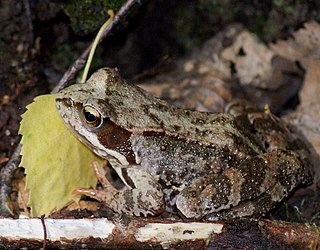
The moor frog is a slim, reddish-brown, semiaquatic amphibian native to Europe and Asia. It is a member of the family Ranidae, or true frogs. The frog is known for its expansive range covering a significant portion of Eurasia. Male frogs are also known to develop temporary blue coloration for mating. The frog has an IUCN listing of Least Concern but it varies in some countries. France and Romania consider the frog nearly extinct and critically endangered, respectively.

The Italian agile frog, also known as Lataste's frog, is a species of frog in the family Ranidae. The species is native to southern Europe, primarily found in the Po River Basin of Italy. It is one of the most endangered amphibian species in Europe, with its populations declining sharply in recent years, and has been the focus of multiple conservation plans.
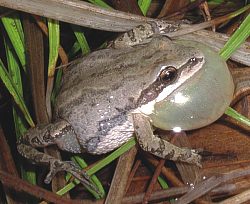
The western chorus frog, also known as striped chorus frog, or midland chorus frog is a species of frog found in Canada and the United States.

Rana amurensis is a species of true frog found in northern Asia. It ranges across western Siberia, as well as northeastern China, northeastern Mongolia, and on the northern Korean Peninsula and on Sakhalin. Rana coreana was previously included in this species as a subspecies. Found at latitudes up to 71° N, it is the northernmost wild amphibian species.

Pelophylax nigromaculatus, is a species of true frog found in East Asia, first described in 1861. This widespread and common frog has many common names, including dark-spotted frog, black-spotted pond frog, and black-spotted frog.
"Centrolene" petrophilum is a species of frog in the family Centrolenidae. Also called the Boyaca Giant Glass Frog.
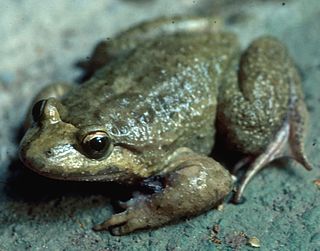
The Corsican painted frog is a species of frogs in the family Alytidae.

The Tyrrhenian painted frog is a species of frog in the family Alytidae.

Dendropsophus phlebodes, the San Carlos treefrog or San Carlos dwarf treefrog, is a species of frog in the family Hylidae. It is found in western Colombia, Costa Rica, Nicaragua and Panama. Its natural habitats are tropical moist lowland forests, but it may also occur in disturbed habitats. It is threatened by habitat loss.
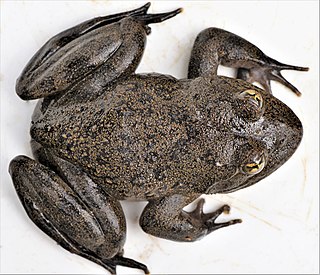
Amietia vertebralis, also known as Maluti river frog, aquatic river frog, ice frog, large-mouthed frog, or water frog, is a species of frogs in the family Pyxicephalidae. It is an aquatic high-altitude species found in Lesotho and neighbouring South Africa.

The Epirus water frog is a species of frog in the family Ranidae. It is found in western Greece, including Kerkyra, and the southern areas of Albania. The species is collected from the wild for human consumption.

The river frog is a species of aquatic frog in the family Ranidae. It is endemic to the southeastern United States. Its natural habitats are temperate rivers, swamps, freshwater lakes and freshwater marshes. It is threatened by habitat loss.
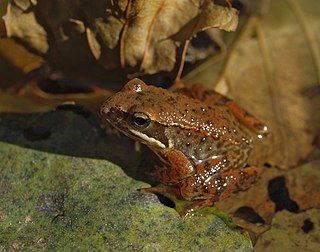
The Iberian frog, also known as Iberian stream frog, is a species of frog in the family Ranidae found in Portugal and Spain. Its natural habitats are rivers, mountain streams and swamps. It is threatened by habitat loss, introduced species, climate change, water contamination, and increased ultraviolet radiation.
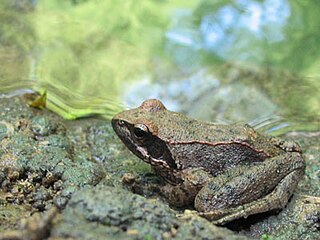
The Italian stream frog, also called the Italian frog, is a species of frog in the family Ranidae. The species is endemic to Italy and San Marino.
